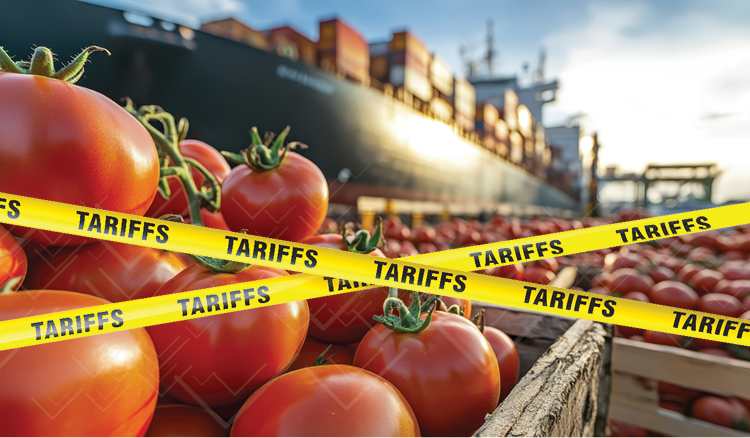Trump 2.0 Week 26 In Review: Breaking Down The Most Important Tariff & Trade Developments That Business Leaders Should Care About
This week, the White House delivered a meaningful win for U.S. manufacturing with a new trade deal with Indonesia, unlocking access to key export markets and securing billions in industrial contracts. At the same time, President Trump signaled a more aggressive trade posture with fresh tariff threats on pharmaceuticals, semiconductors, and several key partners. But beneath the policy moves, major players are already placing long-term bets on domestic manufacturing —underscoring a broader industrial shift.
Developments covered this week include:
- U.S. reaches trade deal with Indonesia
- EU prepares retaliatory tariffs while Mexico remains cautiously optimistic
- Commerce Department opens section 232 investigation into drone & Polysilicon imports
- Trump threatens Russia with steep tariffs unless Ukraine war is ended
- Trump Slaps 17% Tariff on Tomato Imports from Mexico
- Trump threatens to impose pharma & chip tariffs by August 1st
- Commerce Department Targets Graphite Imports with New Tariffs
New Trade Deal With Indonesia Marks Major Win for U.S. Manufacturing
On Tuesday, President Trump announced a new trade deal with Indonesia, touting it as a catalyst for strengthening U.S. industry and creating American jobs. Under the agreement, Indonesian goods will face a 19% tariff when entering the U.S. (down from 32%), while American exports to Indonesia will enjoy duty-free access. Also as part of the deal, Indonesia has agreed to purchase $15 billion in U.S. energy products, $4.5 billion in agricultural goods, and 50 Boeing jets—moves expected to boost domestic production and generate thousands of American jobs. Trump framed the agreement as a major win for U.S. farmers, manufacturers, and workers, emphasizing the new opportunities to tap into Indonesia’s large and growing consumer market.
Though official documents have yet to be released and Indonesian confirmation remains informal, early signals from Indonesia’s leadership suggest alignment on the deal’s broad outlines. President Prabowo Subianto noted a positive conversation with Trump, calling it the beginning of a new, mutually beneficial trade era between the two countries. With an $18 billion trade deficit with Indonesia last year, the U.S. stands to benefit significantly from more balanced and open trade. For Trump, this deal represents another step in revitalizing U.S. manufacturing by securing markets abroad and reducing barriers for American exports.
Europe Prepares to Hit Back After Trump’s 30% Tariff Threat, While Mexico Optimistic a Deal Can Be Reached
President Trump's announcement last weekend of a 30% tariff on imports from both the European Union and Mexico has sparked strong reactions ahead of the August 1 implementation date. The EU swiftly condemned the move as “absolutely unacceptable” and is preparing a retaliatory package targeting up to €72 billion in U.S. goods. While European leaders have paused immediate countermeasures to allow for negotiations, they remain unified and ready to respond if talks collapse. The bloc is also accelerating efforts to diversify trade ties through agreements with partners like Indonesia, Japan, and Mercosur, underscoring concerns about overdependence on U.S. markets. Brussels warns that the tariffs could destabilize transatlantic trade and drive up consumer prices across sectors, from electronics to pharmaceuticals.
Meanwhile, Mexico is taking a more measured stance. President Claudia Sheinbaum expressed optimism that a deal could be reached before the deadline, and analysts suggest that the impact of the tariff—especially if it targets only non-USMCA-compliant goods—may be limited. Nonetheless, the move introduces uncertainty for industries like agriculture and auto manufacturing that rely on cross-border supply chains. Still, markets appear unfazed, interpreting the tariff threats as part of a familiar negotiation pattern rather than a fundamental break in trade relations.
New Drone Tariff Threat Emerges from Commerce Department Investigation
The U.S. Commerce Department has initiated two new national security investigations under Section 232 of the Trade Expansion Act, this time targeting imports of unmanned aircraft systems (UAS) and polysilicon, a vital material used in solar panels and semiconductors. These probes could result in tariffs if the imports are found to threaten national security. The Department has 270 days to complete the investigations and report its findings, after which President Trump can impose tariffs without needing congressional approval.
Expected to conclude by March 2026, the investigations feature shortened public comment periods and no planned hearings, reflecting an expedited process. These measures are part of President Trump’s broader trade strategy, which has leveraged Section 232 tariffs to protect critical industries including steel, aluminum, copper, pharmaceuticals, and semiconductors.
Russia To Face Steep Tariffs in 50 Days Unless Ukraine War Ends
President Donald Trump has issued a 50-day ultimatum to Russia, threatening steep tariffs and secondary sanctions unless a peace deal with Ukraine is reached. In a sharp shift from earlier pauses in military aid, Trump announced new U.S. and NATO-backed weapons deliveries to Kyiv, including Patriot missile systems. He cited mounting frustration with Russian President Vladimir Putin and ongoing attacks on Ukrainian cities as reasons for the policy change. Trump warned that Russian exports could face tariffs of up to 100%, and that countries continuing to trade with Moscow—such as China and India—could also be targeted through secondary sanctions.
If enacted, these sanctions would significantly escalate pressure on Russia’s fossil fuel-dependent economy, which still derives over half of its export revenue from energy. While existing Western sanctions have raised Russia’s export costs, they’ve done little to curb volumes. Analysts estimate that cutting off major energy flows through secondary sanctions could slash Russia’s export earnings by $75 billion annually and trigger a fiscal crisis.
U.S. Tomato Growers Score Win as Mexican Imports Face 17% Tariff
On Monday, the Trump administration announced a 17% tariff on most Mexican tomato imports, marking a strategic win for American producers, who have long struggled to compete against low-cost foreign produce. With roughly 70% of all tomatoes consumed in the U.S. currently sourced from Mexico, the new tariff is expected to shift market dynamics in favor of U.S. growers, stimulating domestic production, investment in greenhouse infrastructure, and job creation across farming, food processing, and distribution.
The move, which follows the U.S. withdrawal from a 2019 trade suspension agreement, comes in response to longstanding complaints that Mexican exporters were undercutting American farmers by flooding the market with below-cost tomatoes. While Mexico has rejected these claims, the economic consequences for its agricultural sector could be significant. Tomatoes are one of Mexico’s most valuable produce exports to the U.S., and losing even a fraction of that 70% market share would inflict considerable revenue losses on its growers and supply chains. The Mexican government has acknowledged the threat, pledging to seek new markets—but with U.S. demand so central, that transition may be slow and difficult. Meanwhile, U.S. producers now have a rare opportunity to expand their foothold in a critical segment of the produce market.
New Tariffs Aim to Jumpstart Domestic Drug and Chip Production
President Trump has once again announced plans to impose tariffs on pharmaceutical products and semiconductors starting as early as August 1. The tariffs, which would begin at a lower rate and increase significantly over the course of a year or more, are intended to give companies time to relocate production and invest in domestic facilities. Trump suggested pharmaceutical tariffs could eventually reach 200%, creating strong incentives for drugmakers to build in the U.S., while similar steps are being considered for semiconductors—an industry critical to everything from smartphones to defense technology.
The proposed tariffs mark a significant shift toward reindustrializing core sectors of the U.S. economy. If implemented, they could lead to a resurgence in advanced manufacturing, boosting job creation, innovation, and supply chain security. Trump framed the plan as a long-overdue correction to decades of offshoring that left the U.S. vulnerable in strategic industries. By encouraging companies to manufacture essential products like medicine and microchips on American soil, the administration aims to strengthen economic resilience and reduce dependence on foreign suppliers—especially in areas deemed vital to national security and public health.
U.S. Targets Graphite Imports with New Tariffs
On Thursday, the U.S. Commerce Department imposed preliminary anti-dumping duties of 93.5% on Chinese graphite imports, raising the total effective tariff on anode active material (AAM) to approximately 160% when combined with earlier countervailing duties and existing trade tariffs. This action follows a petition from the American Active Anode Material Producers and aims to bolster domestic graphite manufacturing, reduce dependence on China—which currently supplies nearly two-thirds of U.S. imports—and support the growing demand for electric vehicle (EV) batteries. While the tariffs may increase short-term costs, experts view them as a strategic step toward enhancing U.S. supply chain resilience, energy independence, and competitiveness in the global battery materials market. The final determinations for both the anti-dumping and countervailing duty investigations are expected by December 5, 2025.
Thriving Amidst Uncertainty - The Veryable Advantage
As global trade realigns and the Trump administration advances its industrial policy agenda, the outlook for domestic manufacturing has never been more promising. Strategic tariffs, new trade agreements, and rising investment in critical sectors are creating the conditions for an American manufacturing resurgence. However, this new environment also demands greater agility. Supply chain disruptions, shifting tariff timelines, and market volatility have become constants—requiring operational models that can adapt in real time.
Veryable enables that adaptability. Our on-demand labor model empowers manufacturers and distributors to scale their workforce dynamically, based on real-time demand rather than unreliable forecasts. By replacing outdated, rigid labor models with a flexible, real-time approach, businesses gain the ability to respond immediately to production shifts, limit fixed cost exposure, and maintain world-class service no matter what. Across the U.S., businesses are turning to Veryable to modernize their labor strategies—shortening lead times, increasing productivity, and maximizing operational agility. In a moment defined by both challenge and opportunity, labor flexibility is no longer a luxury—it’s a strategic imperative.
Ready To Get Started?
Talk to an Expert Create Free Business Profile
Additional Resources
U.S. Manufacturing Today Podcast
For more information and insights, make sure to check out our new U.S. Manufacturing Today Podcast. Hosted by our Head of Reindustrialization, Matt Horine, and featuring interviews with business leaders as well as industry experts, this podcast covers the latest trends and shifts affecting the U.S. manufacturing and distribution sectors.
In this week’s episode, GE-trained operations leaders and Veryable’s West Division President Pat Dippel dives deep into why operational flexibility has become a cornerstone of competitiveness.
You can find this podcast on our website, Spotify, Apple, YouTube, and PocketCasts.
Navigating Trump 2.0
For additional insights into the developments under Trump 2.0, visit our “Navigating Trump 2.0” page. There you'll find comprehensive information on recent and potential future changes, along with a collection of articles offering guidance for manufacturers and distributors on how to succeed in this rapidly evolving environment.
Veryable Vendor Network
The Veryable Vendor Network (VVN) is an ecosystem of manufacturing, warehousing, and logistics companies that utilize Veryable to deliver quality products and world-class service to their customers regardless of demand. If you’re looking for new domestic suppliers, submit a form and our team will be in contact shortly after.
Previous Posts
Capitalizing on Q4 Opportunities: How Forward-Thinking Business Leaders Are Scaling Smarter
The Future of Manufacturing and Logistics
Create a free business profile today to explore our platform.






